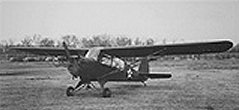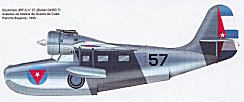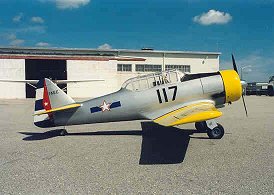

The Cuban Air Force at the Second World WarRuben Urribarres |
![]() Organization changes of the Aviation
Organization changes of the Aviation

In June 3, 1940
was created the ANACRA(Academia Nacional de Aviación Civil Reserva Aérea
or National Academy of Civil Aviation, Air Reserve). A civic-military academy
for the training of civilian pilots, throughout the use of military instructors. At the beginnings the ANACRA have
4 Aeronca airplanes and 150 students. The flights are done in the camp "Major
Manuel Pérez Alfonso", in the lands of the airport of Rancho Boyeros.
 Los Aeronca L-3B son recibidos para ANACRA en 1943
Los Aeronca L-3B son recibidos para ANACRA en 1943
1939 Aviation School Promotion
José A. Alonso, Miguel A Alonso
Estévez, Benigno Díaz Doval, Francisco Fernández Bernaza,
José A. Fernández Martínez, Jorge González Rojas,
Luis González Rojas, Angel Gutiérrez Vásquez, Mario León
González, Celso Mancitos, Luis Palacios, Manuel Reboso Brito.
In 1940 the Cuban Navy performs another flight of good will "Pro Faro de Colón" around 22 countries of Latin America, in a Howard DGA-8, that flying some 36 000 km without any incident.
1941
Aviation School Promotion
Alfredo
Acosta Iglesias, Benito Aldecocea Lopez, Juventino Baez Rodríguez, Gaston
Bernal Fernández, Julio Caballero García, Agustín Cartaya,
Jorge Casales Escarras, Jorge Casanova Pellicer, Felipe Catasús Pazos,
Francisco Cuadra Aguirre, Alberto Dávila Sala, Jorge Escobar Quesada, Alfredo
Fernández Nespral, Eduardo Ferrer del Castillo, José E. García
D'Abrigeon, Antonio González Torrecilla, Angel Gutiérrez Vásquez,
Heriberto Hernández Nevares, Manuel Martínez Saladrigas, Máximo
Pruna Hernández, Pedro Roque Lazar, Victor San Julián Casas, Alfonso
Silva Tablada, Rene Somodevilla, Carlos M. Tabernilla Palmero, Jorge Triana
Díaz, Lorenzo Triana Roche.
![]() Airplanes bought in 1939-1941
Airplanes bought in 1939-1941
Before the beginning of the II World War, were acquired seven Stearmans A73B1 of training that arrived among July of 1939 and March of 1940 (N° 43-44-45-46-47-48-49).
October 21, 1939 was lost a CW-19. In April of 1941 were bought four Aeronca 65TC, that passed to the ANACRA. The naval aviation was equipped also with Howard DGA-8, Howard DGA-15 and anfibios Grumman G-21 / JRF-5 Goose
| Grumman JRF-5 Goose N° 57 (BuAer 04360), Cuban Naval Aviation, Rancho Boyeros, Havana, 1945 (Courtesy of Andrés Huerta) |  |
![]() Cuba enters the War
Cuba enters the War
December 7, 1941 the Japan attacks the US in Pearl Harbor. Following to the United States, Cuba declares the war to the Japan in December 9 and to Germany and Italy in December 11. In the new situation, the ANACRA is recorded to the National Department of Defense December 22. The Germans submarines sank 4 Cuban ships: the "Mambi", the "Manzanillo", the "Santiago" and the "Libertad", that they carried different loads to United States. In them 56 Cuban sailors died.
But the Cuban Navy also
acted. In May 15, 1943 the Cuban anti-submarine ship SC-13, with aid of the information
of an American Kingfisher, sank the German submarine U-176, sufficing only two
loads of depth. In this submarine died their 53 crewmant next to their Captain
Reiner Dierksen, near the Province of Matanzas. Mariano Faget was the agent
what discovered to Lunin, the German spy that worked in Havana transmitting information
to his submarines. The spy was executed.
 | The Vought OS2U Kingfisher of the Cuban Navy made hundreds missions in anti- submarines role (Courtesy of Tony Rogers) |
![]() New aiplanes for the conflicts
New aiplanes for the conflicts
Due to the geographical position of the island of Cuba, at the entrance of the Gulf of Mexico, the heavy traffic of maritime lines and the great natural resources of the island, Cuba and the Air Corp became the best beneficiary of the Lend/Lease programs of the United States. Against the wishes of the Army and Navy, the Air Corp. received 48 airplanes. These airplanes are used fundamentally for training in dress to future combat airplanes, and as antisubmarine patrol.
- Jul 1942 - 6 Boeing-Stearman PT-17 N° 38-39-40-41-42-43
- Sept 1942 - 3 Vultee BT-13 N° 66-67-68
- Oct 1942 - 3 Vultee BT-13 N° 69-70-71
- Oct 1942 - 3 North American AT-6C N° 100-101-102
- Nov 1942 - 3 North American AT-6C N° 103-104-105
- Feb 1943 - 3 Vultee BT-13 N° 72-73-74
- May 1943 - 11 Aeronca L-3B N° 1-2-3-4-5-6-7-8-9 10-11. Para la ANACRA.
- Jun 1943 - 3 North American AT-6 N° 106-107-108
- Jun 1943 - 3 Boeing Stearman N2S-4 N° 44-45-46
- May/Jun 1945 - 10 North American AT-6F N° 111-112-113-114-115-116-117-118-119-120
 |
|  |
The Cuban Navy receives in July of 1942 three Vought OS2U-3 Kingfisher (N° 49, 50, 51), for the patrol against Germans submarines. Habitually they carried two bombs of 54 kg and its Cal.30 machine gun.
In the same one 1942 is build the first airplane manufactured in Cuba, the CUT-143 "Estrella Errante" ("Wandering Star"), designed and build by the Major Benigno Díaz y Doval, 1th Lt. Jorge Merlo and the Mr. Roberto Gude.
The Air Corp received a Beech S.17D "Staggerwing" number (1) for transport duty, this airplane was confiscated to Senator Emilio Ochoa and two Stinson, one model 105 number (2) given as a gift to the Corp by Miss Celia Velazco and the other a model 108 numbered (3).
![]() The americans landed in Cuba
The americans landed in Cuba
The Sep 9, 1942, Cuba and United States sign a new naval and military agreement of cooperation. The strategic importance of Cuba for the air and maritime communications of United States and the importance of its production of sugar, obliged them to reinforce the island. During the Second World War the San Antonio Air Base, also known as the Cayuga was built near a town of the same name in the Havana Province, by the United States Engineer Corps, and the San Julian Air Base in the Guanacabibes peninsula in Pinar del Rio was also built. The San Antonio field was named "Batista Field" in recognition of the Batista´s help.
 | Crewman of an B-24 Liberator of the 514th Bomb Squadron, 376th Bomb Group, USAAF 15th Air Force, that were training in San Antonio, Cuba. This squadron fought in Italy since 1944 |
Since there American airplanes fly in patrol by the Caribe, to the hunt of Germans submarines ( the USAAF flying since San Antonio and the US NAVY since San Julián). In June from 1942 the US NAVY establishes air facilities in La Fe and a station of globes in San Julián. Both airports were passed to the Cuban Army for the use of the Aviation Corp, after the War during the government of President Ramon Grau San Martin. San Antonio Air Base was used by the military aviation at all times, not so San Julian Air Base that was used as a mechanics school. Many American squadrons are training in Cuba in navigation, bombing, shot to air and land objectives, flights in extreme conditions. A fighter squadron of P-39 Airacobra was placed in San Antonio for their defense. Besides, Cuba was used like scale of the flights since US to Europe and Medium East, way South America and Africa.
To end of 1944 and begins of 1945 is also intensely training in Cuba the USAAF 509th Bombing Squadron of B-29. Is the created to throw the Atom Bomb over Japan. They carry out long flights upon Cuba and their around upon in sea, being become accustomed to similar conditions to the Pacific Ocean. Then they are envoys to the Islands Marianas, Pacific, in June of 1945. They are the ones that would throw the atom bombs upon Hiroshima and Nagasaki in August of 1945. Among them also was the Enola Gay.
![]() The training programm increased
The training programm increased
| |  |
1943
Aviation School Promotion
Jorge
Alemany Pelaez, Ramón Alonso Guillot, Nestor Alvarez Fernández,
Enrique Becalli, Mario Cabréras Bosque, Enrique Carreras Rolas, José
M Castellanos Reyes Gavilán, Roberto Cendoya Echevarria, Guillermo Corvo
Alzamora, José de la Peña García, Oscar del Valle Cabieris,
Enrique Domínguez Pérez, Mario Dutil Somodevilla, Humberto Hernández
Nevares, Jorge Foyo González, Rolando García Baez, Juan A García
Rodríguez, Leopoldo Infante Fernández, Luis Larrea González,
Rafael Lima Silva, Tomas Lingoya y Gonzales Clave, Vilorio Mata, Miguel Matamoros
del Valle, José Matos Méstre, Hubert Masmontet Pompeidin Cuervo,
Rogelio Miró Quiros, Juan Olivéra Hermida, Pablo Palmero Diehl,
Luis Pérez Escandon, Jorge Perramón Spencer, Agustín Piñéra
Machin, Carlos Pirri Llorca, Ernesto Puig Miyar, Manuel Ramírez Sotto,
Marcelo Tabernilla Palmero, Cosme A Varas Castro, Manuel Vidal Méndez,
Ricardo Zorrilla Armenteros.
On February 12th., 1943 6 AT-6 took off
in a good will flight to Mexico City where they stayed for 17 days giving demonstrations
and interacting with the personnel of the Mexican Air Force.
 |
|  |
The AT-6 flew anti submarine patrols from the Preston Airport in Oriente Province and between longitudes 75 and 77 West of the Cuban northern coast in order to protect the maritime navigation routes, which they kept open and protecting the nickel mines at Nicaro. During the month of June 1945, and escadrille of 3 AT-6 flew a good will mission to Mexico City, on the controls were Captains Roberto Henderson Besanilla, Laureano Garcia Berrocal and Francisco Gutierrez and as mechanics Sergeants Barrios and Delfin Burias. On the leader plane Captain Henderson was carrying Col. Otalio Soca Llanes, Chief of the Air Corp as a passenger.
![]() Accidents in the period 1943-45
Accidents in the period 1943-45
The great increment of the intensity of the flights brings like consequence various accidents. The 21st of July 1943 Captain Roberto Roque and his mechanic Fernando Cubas, while flying a Vultee numbered 72 had a fatal accident in Guines, La Habana, coming out of a dive and crashing against huge tree.
On an accident, crashing against the hills near the town of Artemisa in Pinar del Rio Province, during formation flying training, Major Manuel Perez Alfonso (that in those moments was the Air Corp´s Chief) and his instructor Captain Efrain Hernandez D'Abrignon in one airplane and Aviation Cadet Somodevilla in the other plane. In this accident lost their lives Major Perez Alfonso and Cadet Somodevilla. Captain Hernandez D'Abrignon miraculously saved his life, but was so badly wounded that never flew again. Lt. Luis Insua killed himself in an accident over Baracoa Beach in the Havana Province, while flying a PT Ryan.
During the months of March 1944 and while flying an ANACRA aircraft Lieutenant Jose Rodriguez had an accident at Boyeros Airport. Later on, during the months of May, Lieutenant Vasquez of the 1941 promotion, while flying a metallic Curtiss R-19 with a Wright engine of 425 hp, suffered a fatal accident while flying with his instructor Captain Palacios near the sugar mill "Toledo" in the Havana Province. Also, Lieutenant Pepin Fernandez flying a Vultee BT-13 had a reversible stall during the approach to the sugar mill "Steward" runway with a crosswind. The Lieutenant Larin died on an accident while flying an AT-6 at the Maisi runway in Oriente Province.
March 11, 1945 two airplanes of the Cuban Navy forced landed near Jacksonville, USA. They returned from the Canada. One of theys was crashed, being injured the pilot. The other airplane to save.
In July the 16th of 1945 the Lieutenants
Zorilla and Henderson flying a C-45 number 212 and carrying as a passenger Major
Rivero, an aid to the Chief of the Army suffered an accident while on an approach
to the Charleston Airfield in South Carolina, United States while returning from
a flight of two aircraft to Washington DC. In the other aircraft piloted by Lieutenant
Fernandez "El Callao" was on board the Chief of the Cuban Army General Genovevo
Perez Damera.
![]() Related articles
The Trasatlantic Flight of Menendez Pelaez
1913. Audacious Flight of Rosillo and Parlá
1933-1938, Cuban Military Aviation. The 1933 Revolution and her consequences.
Related articles
The Trasatlantic Flight of Menendez Pelaez
1913. Audacious Flight of Rosillo and Parlá
1933-1938, Cuban Military Aviation. The 1933 Revolution and her consequences.
![]() External Links
Cuban Military Forum
External Links
Cuban Military Forum
|
|
|
|
|||
